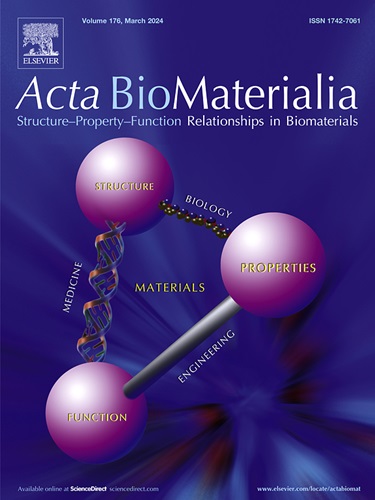空间靶向氧化应激三重放大通过有效调节金属离子价态增强肿瘤治疗。
IF 9.4
1区 医学
Q1 ENGINEERING, BIOMEDICAL
引用次数: 0
摘要
通过金属离子激活的生物催化作用诱导氧化应激是金属离子干扰疗法(MIIT)的基本机制。然而,金属离子的随机价态和散射空间往往限制了金属离子干扰疗法的实际催化效率。本文通过金属离子价态调控策略合成了包覆牛血清白蛋白的铜铁双金属硫化物纳米粒子(CFS NPs)。CFS NPs释放出大量的铜⁺和铁⁺,这对于催化芬顿样反应至关重要。Fe³⁺的存在进一步提高了Fe²⁺的可用性,并通过消耗谷胱甘肽(GSH)防止羟自由基(-OH)的消除,从而扩大线粒体氧化应激,诱导细胞凋亡。这种氧化应激损伤表现为以线粒体三羧酸(TCA)循环为目标的 Cu+,进一步导致蛋白毒性应激和杯突症。脂质过氧化物(LPO)的产生和谷胱甘肽过氧化物酶 4(GPX4)表达的失活也会受到氧化应激放大的影响,从而实现高效的铁变态反应。因此,凋亡/嗜杯酸酶/铁氧化多模式协同疗法几乎完全抑制了体内肿瘤的生长。相信 CFS NPs 通过对金属离子价态的合理调控和精确的空间控制,有效改善氧化应激水平,为肿瘤的多重联合治疗提供了可行的意义。意义声明::金属离子干扰疗法通过金属离子激活的生物催化作用诱导肿瘤细胞氧化应激,影响活性氧(ROS)水平、蛋白毒性应激和脂质过氧化累积。然而,金属离子干扰疗法的实际催化效率往往受限于这些金属离子的随机价态和散射空间。在此,我们通过金属离子价态调控策略构建了可变价态铜铁双金属硫化物纳米粒子(CFS NPs),以克服制约凋亡/杯突/铁突变三重氧化应激空间治疗组合效率的关键因素。正常细胞内的酸度和 GSH 浓度降低,导致对正常细胞的细胞毒性大大降低,因此在生物医学应用中具有更高的生物相容性和生物安全性。本文章由计算机程序翻译,如有差异,请以英文原文为准。

Spatially targeted triple amplification of oxidative stress for enhanced tumor therapy via effective modulation of metal ion valence states
Inducing oxidative stress through metal ions activated biocatalysis is a fundamental mechanism of metal ion-interference therapy (MIIT). However, the actual catalytic efficiency of MIIT is often limited by the random valence states of metal ions and scattered space. Herein, copper-iron bimetallic sulfide nanoparticles coated with bovine serum albumin (CFS NPs) are synthesized through metal ion valence modulation strategy. Significant amounts of Cu⁺ and Fe²⁺ were released by CFS NPs, which is crucial for catalyzing Fenton-like reaction. The presence of Fe³⁺ further boosts Fe²⁺ availability and protects against hydroxyl radical (•OH) elimination via glutathione (GSH) consumption, amplifying the mitochondrial oxidative stress to induce apoptotic cell death. This oxidative stress damage is manifested in Cu+ targeting the mitochondrial tricarboxylic acid (TCA) cycle, further causing proteotoxic stress and cuproptosis. The production of lipid peroxidation (LPO) and the inactivation of glutathione peroxidase 4 (GPX4) expression are also affected by the amplified oxidative stress to achieve efficient ferroptosis. As a result, the synergistic apoptosis/cuproptosis/ferroptosis multimodal therapy almost completely inhibits tumor growth in vivo. It is believing that CFS NPs provide feasible implications for multiple combination therapy of tumors with the rational regulation of metal ion valence state and precise spatial control to effectively improve the level of oxidative stress.
Statement of Significance
: Metal ion-interference therapy induces oxidative stress in tumor cells via metal ion-activated biocatalysis, influencing reactive oxygen species (ROS) levels, proteotoxic stress, and lipid peroxidation accumulation. However, the actual catalytic efficiency of metal ion-interference therapy is often limited by the random valence state of these metal ions and scattered space. Herein, we constructed variable valence copper-iron bimetallic sulfides nanoparticles (CFS NPs) through metal ion valence modulation strategy to overcome the key factors that constrain efficiency with the combination of triple oxidative stress spatially treatment for apoptosis/cuproptosis/ferroptosis therapy. The reduced acidity and GSH concentration within normal cells lead to a much low cytotoxicity to normal cells, and therefore higher biocompatibility and biosafety for bio-medical applications.
求助全文
通过发布文献求助,成功后即可免费获取论文全文。
去求助
来源期刊

Acta Biomaterialia
工程技术-材料科学:生物材料
CiteScore
16.80
自引率
3.10%
发文量
776
审稿时长
30 days
期刊介绍:
Acta Biomaterialia is a monthly peer-reviewed scientific journal published by Elsevier. The journal was established in January 2005. The editor-in-chief is W.R. Wagner (University of Pittsburgh). The journal covers research in biomaterials science, including the interrelationship of biomaterial structure and function from macroscale to nanoscale. Topical coverage includes biomedical and biocompatible materials.
 求助内容:
求助内容: 应助结果提醒方式:
应助结果提醒方式:


